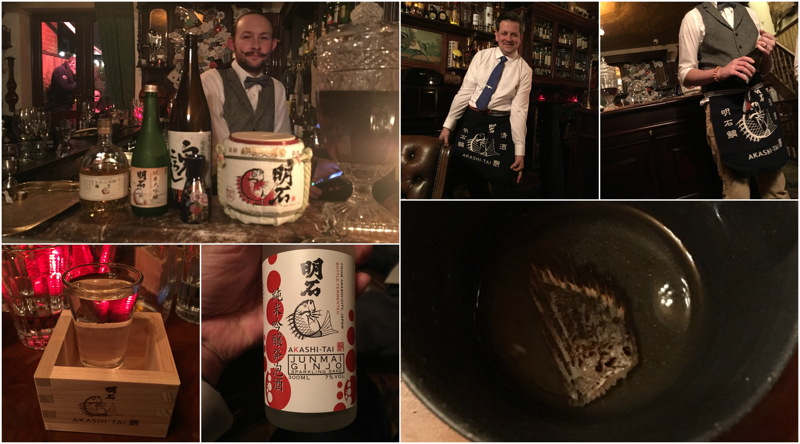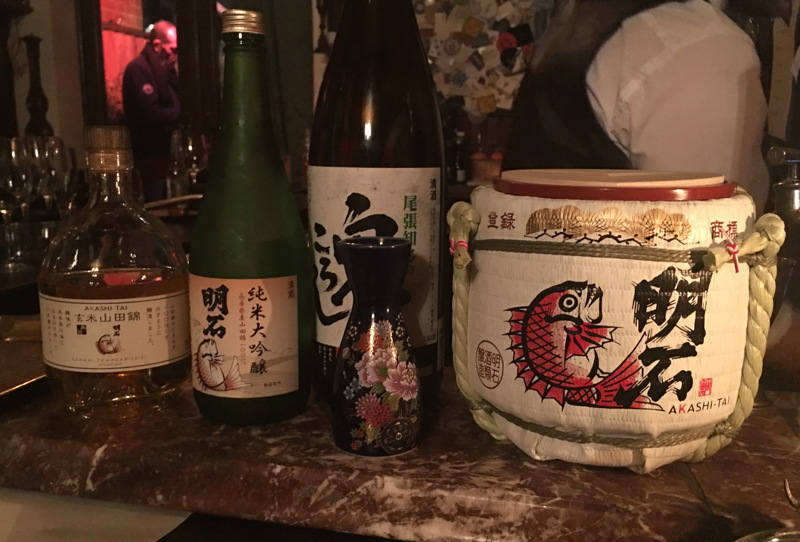Dave Hall from the Larder House/Library of Liquor took us through a very interesting evening tasting different Japanese sake and learning about its background and the part that milling process plays.
7 sake were on offer and a couple of them had a little extra treatment to make them traditional and memorable, although for some it was a bit too much, ha ha. You shall see.
All dressed up in Akashi Tai aprons Dave and Salvatore were ready to get the evening rolling, as opposed to getting down to some deep and dirty sumo wrestling. Dave began by giving some background to the brewing process and how sake is more akin to beer than wine. Many of the sake makers are small scale, and the product can be totally encompassing for the people working there, sleeping and waking to turn the rice over and so on on a regular basis. Amazing.

One process that is a central part of production is the milling or polishing of the rice grains. That process takes off the outer layer of protein and fatty substances. Sake is classified by the different milling rates, so a milling rate of 60% means the outer 40% has been removed. A milling rate of 100% means the rice grains have had little done to them.
(1) First up was the Akashi Tai Honjozo (65% milling rate), served in a small glass sitting in a square wooden box called a "masu". Slightly over-pouring the measure into the glass is a traditional Japanese sign of showing generosity, but with the box being there meant I could pour it back into the glass, a traditional British sign of not wasting any booze. Served chilled, it was clean refreshing start to the evening.
We then had the same sake but this time it was served warm at around 55 degrees, and that presented a much sweeter profile and aroma. Nice to have been able to compare and contrast the same drink in this way.
(2) The sparkling sake was served chilled in a champagne flute - the Akashi Tai Junmai Ginjo sparkling sake (60% milling rate) got lots of love from around the room. Even at 7%, this was a very sophisticated drink that surprised so many people. I need to try this kind of drink again but it is a little pricey for a small bottle given the ABV. Something to try at your next dinner party to impress your guests.
(3) Akashi-Tai Daiginjo (40% milling rate) - Having said that, the next sake came out in a dark earthenware cup and had a fish tail in it. Hey, now that has got your attention. This one didn't get quite as much love as the sparkling sake for sure! Smokey aroma, basically from when Dave charred them. A savoury salty approach to it. Although it isn't the same kind of drink as a Talisker Storm, that was the first drink that came to mind. A few not-brave souls admitted defeat and left alone.
(4) Owari Chita Onikoroshi (78% milling rate) - This sake, served in a large wine glass so just like a crisp white wine in aroma and taste.
We rinsed the wine glass out ready for the next.
(5) Akashi-Tai Junmai Daiginjo (40% milling rate) - This next sake had such a bright green plummy nose to it. Very enticing. I was thinking that it would be like a sauvignon blanc but the taste was so different to what I perceived it would be. That's not to say it is bad or wrong - because I simply don't know. Whilst the nose seemed bright and fresh, the drink had more of a fuller mouthfeel to it.
So interesting so far.

(6) Urakasumi Zen Junmai Ginjo (50% milling rate) - How this sake was served reminds me of my childhood. You might be thinking "Really?". It was served like a warm eggnog, called "tamagozake". It had a mixed reaction, just like the fish tale one, but I just find it a comforting drink. Anyway, back to the childhood thing. It was a dish, well more of a dessert, that my mother used to make where in a flat flat bowl she would mix beaten egg, milk, sugar and probably brandy (whilst I've tried whisky) and then gently steam it until it was just set. Be careful with the steaming as the last time I tried, I whacked up the heat, took my eye of it, wasted time on Social Media so by the time I opened the lid, it was set hard and dimpled. Mother says the trick is to lift the lid frequently to release the steam. I will try again, now that I have had time to spur me on.
(7) Akashi-Tai Genmai Aged Saked (100% milling rate) - The final sake was an aged one. This has colour to it, but not from wood as it is aged in the steel vats. A heady interesting nose to it. Again, from the nose I had a perception of a much heavier drink but it came through like a fino sherry. Maybe even like an En Rama, but I would need to try them all again to really say.
This is what I love about these events at the Library. It opens the lids on new drinks, but more importantly you get to try a range of quality drinks representing different aspects of the booze in question.
Websites: Akashi-Tai, Urakasumi


